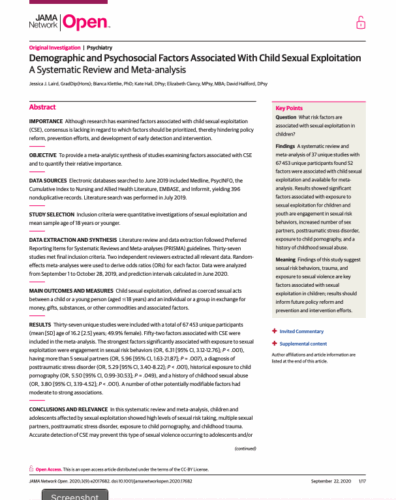Grooming, Child Abuse, & Child Sexual Exploitation
Demographic and Psychosocial Factors Associated With Child Sexual Exploitation: A Systematic Review and Meta-analysis.
Open Access: Yes.
Abstract
Importance. Although research has examined factors associated with child sexual exploitation (CSE), consensus is lacking in regard to which factors should be prioritized, thereby hindering policy reform, prevention efforts, and development of early detection and intervention.
Objective. To provide a meta-analytic synthesis of studies examining factors associated with CSE and to quantify their relative importance.
Data Sources. Electronic databases searched to June 2019 included Medline, PsycINFO, the Cumulative Index to Nursing and Allied Health Literature, EMBASE, and Informit, yielding 396 nonduplicative records. Literature search was performed in July 2019.
Study Selection. Inclusion criteria were quantitative investigations of sexual exploitation and mean sample age of 18 years or younger.
Data Extraction and Synthesis. Literature review and data extraction followed Preferred Reporting Items for Systematic Reviews and Meta-analyses (PRISMA) guidelines. Thirty-seven studies met final inclusion criteria. Two independent reviewers extracted all relevant data. Random-effects meta-analyses were used to derive odds ratios (ORs) for each factor. Data were analyzed from September 1 to October 28, 2019, and prediction intervals calculated in June 2020.
Main Outcomes and Measures.Child sexual exploitation, defined as coerced sexual acts between a child or a young person (aged ≤18 years) and an individual or a group in exchange for money, gifts, substances, or other commodities and associated factors.
Results. Thirty-seven unique studies were included with a total of 67 453 unique participants (mean [SD] age of 16.2 [2.5] years; 49.9% female). Fifty-two factors associated with CSE were included in the meta-analysis. The strongest factors significantly associated with exposure to sexual exploitation were engagement in sexual risk behaviors (OR, 6.31 [95% CI, 3.12-12.76]; P < .001), having more than 5 sexual partners (OR, 5.96 [95% CI, 1.63-21.87]; P = .007), a diagnosis of posttraumatic stress disorder (OR, 5.29 [95% CI, 3.40-8.22]; P < .001), historical exposure to child pornography (OR, 5.50 [95% CI, 0.99-30.53]; P = .049), and a history of childhood sexual abuse (OR, 3.80 [95% CI, 3.19-4.52]; P < .001). A number of other potentially modifiable factors had moderate to strong associations.
Conclusions and Relevance. In this systematic review and meta-analysis, children and adolescents affected by sexual exploitation showed high levels of sexual risk taking, multiple sexual partners, posttraumatic stress disorder, exposure to child pornography, and childhood trauma. Accurate detection of CSE may prevent this type of sexual violence occurring to adolescents and/or provide opportunities for intervention and recovery. Therefore, prevention and intervention efforts will likely benefit from integrating these factors into screening, assessment, and treatment.
Relevance
Among “adverse childhood experiences (potentially traumatic events that occur from 0 to 17 years of age) [that] were associated with increased odds of experiencing CSE [childhood sexual exploitation] in adolescence” were exposure to child pornography (5-fold increase), exposure to rape or violent pornography (2-5-fold increase), and sending sexts (3-fold increase).
Citation
Laird, J. J., Klettke, B., Hall, K., Clancy, E., & Hallford, D. (2020). Demographic and Psychosocial Factors Associated With Child Sexual Exploitation: A Systematic Review and Meta-analysis. JAMA Network Open, 3(9), Article e2017682. https://doi.org/10.1001/jamanetworkopen.2020.17682

